Last Wednesday morning, Professor Robert Jan van Pelt sat down at our classroom table in the library and gestured toward an old book on the table.
“Why do you think I brought this here today?” he asked.
We leaned in and looked closely. It was a large hard-bound folio, with a mottled cover. The binding looked new; the paper old. On the spine was written “The Ruins of Palmyra in the Desert.”
“Palmyra is in Syria,” someone said. “Did you bring it because the site is under threat from ISIS?”
“I brought it because this city is being destroyed today,” Robert Jan said.
I stared. I hadn’t seen the news that morning. But I had heard, months before, of another Syrian archaeological site being bulldozed and bombed. Now, apparently, it was happening to Palmyra as we spoke.
We looked through the book for a while, discussed it. It turned out to be an account of a voyage made by the British antiquarian Robert Wood in 1750-51 to the eastern Mediterranean. Travelling with a retinue of companions, Wood explored and documented Palmyra and other ancient sites in the Syrian desert. On his return, he published this book of measured drawings, renderings, and history.
“Reading this, we are, in some way, closer to this city right now than anyone else,” Robert Jan said. For a long time this book was the only source of information people had on Palmyra. Now the city itself is disappearing, and we are left with the book again.
I felt enraged about what IS (Islamic State – a misnomer) was doing. Knowing that archaeological artifacts which had survived for thousands of years were being shovelled around by bulldozers and blown up by improvised explosives… And yet, why was I surprised or shocked by this, knowing the atrocities towards humans which IS had already perpetrated?
Maybe it’s because you expect terrorists to attack people. You don’t expect them to have a grudge against old rocks.
In any case, I wanted to know more about Palmyra. So I came back later in the afternoon, sat in the rare book room, and read Robert Wood’s book. The text was charming. Although riddled with colonialist thinking which alarmingly foreshadows western intervention in the Middle East (paraphrase: “if only we had civilized people in charge, the trade routes here would be so much more profitable”), the narrator makes other statements which seem poignant and relevant in light of this week’s events. These ruins were so little known until recently, he says, that little has been written about them. The ruins are “left to tell their own stories.” Hardly anyone would have noticed, says Wood, if the ruins had been cannibalized to make modern fortifications, and this is “a very strong instance of the precarious fate, that the greatest monuments of human art and power are liable to.”
(Oh! An aside: sometimes reading Wood’s text was an odd experience, because of the old printing practice where some S’s look like lowercase F’s. Therefore, at the centre of the city, I learned that there was a very grand “Temple of the Fun.”)
Anyway. When I checked up on the news stories, I learned that the main element of Palmyra which had been destroyed this week was an “Arch of Triumph.” So I googled a photograph, and looked for a matching drawing in Adam’s book.
Here it is.
This is what we lost, last week.
Above is the view in 1753. Below is the view before last Tuesday.
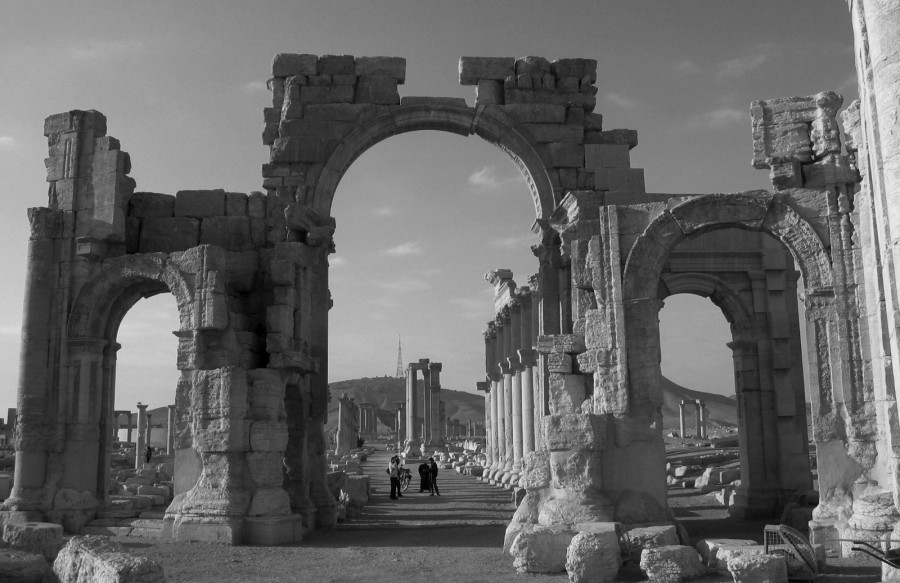
Palmyra: the Arch of Triumph as it appeared until recently. Source: Politiscope, “Unesco Says Destruction of Palmyra’s Arch of Triumph by ISIL ‘War Crime.’
What would we see there now? Stones. Rubble. Desert. A ruin. In fact, it’ll be more like it already is, just with less of it standing up.
Of course this is horrible, and I hope we feel loss and anger on behalf of the local people whose heritage is being systematically destroyed. At the same time, let’s not give IS satisfaction by taking what they say about their actions (destroying “blasphemous” artifacts) at face value. Let’s take a step back and look at the strangeness of what they are doing.
It’s sort of ironic to be demolishing a ruin. Right?
The IS attitude toward history is odd, in that they give no value to historical remains, and yet, by saying, “these old temples are blasphemous,” they bring the dead paganism of Roman times into the present. They are willing to give no distance to the past: they flatten it, treating its remains as though they were part of the present. It doesn’t matter that no one has worshipped Bel or Zeus in this place for nearly two thousand years. The temples must go.
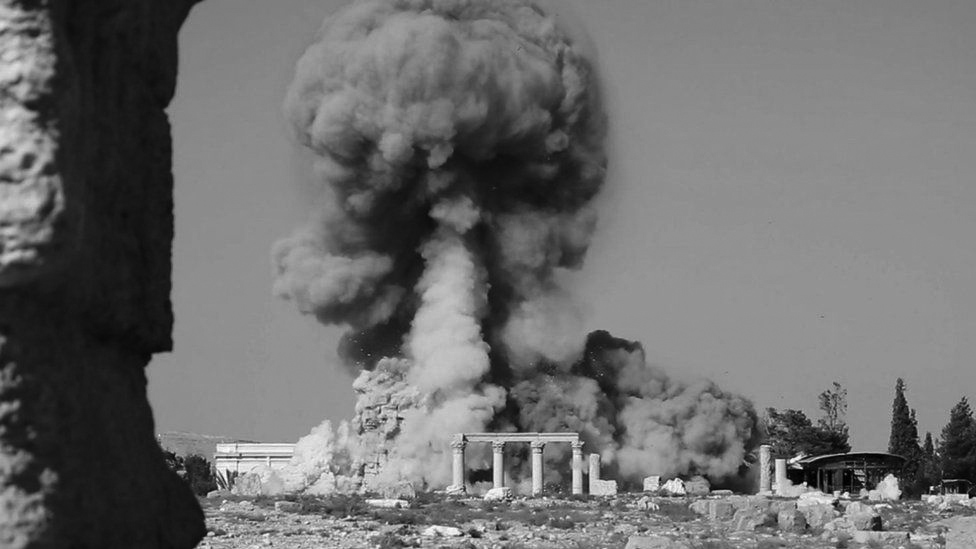
Destruction of the Temple of Baalshamin. Source: Wikipedia, “Destruction of Cultural Heritage by ISIL.”
Robert Wood’s text mentions that Palmyra’s ruins survived because there were “few inhabitants to deface them.” Unlike Rome, Palmyra didn’t get spoliated. There weren’t enough people around to melt down the bronze of its pantheons and make them into church decorations. Nobody was re-using the column capitals. There isn’t really a historical palimpsest here: this is one of the places where we commune with antiquity face to face. And perhaps that’s one reason why IS flattens it, literally and metaphorically: this is a bare-faced confrontation with what the pagan world was like. The temples were never converted to mosques. IS is faced here with the brazenness of the ancient world surviving into the present, and they do not like it. They have no time for the nuance of history; everything that distracts them from Now, the time in which they rule, must go. They project a continual present, creating a terror narrative because they want to distract us from looking at anything except how scary they are.
Do you know what else they don’t want us to look at? The fact that IS is profiting from Palmyra. They blow up the big stuff, but they sell the rest on the black market.
All the more reason, then, for us not to take the bait: to see, instead, through the deep lens of history; to wear glasses with layers and layers of memory.
Canadians are terrible at this. Our cultural memory is incredibly short. We worry about accepting Syrian refugees (because somehow we think that people fleeing from terrorists might also possibly somehow be terrorists too), and we forget that every new group of immigrants to North America has been treated at first with suspicion and prejudice. Irish, Italians, Chinese, Japanese, many others – they were not warmly welcomed in Canada. Now that we’ve gotten used to all the wonderful contributions those immigrants have made to our country, we risk making the exact same mistake again, this time with Syrians. We forget the shared cultural heritage which Christianity shares with Islam and Judaism – exemplified by places like Palmyra, where Robert Wood tells us that legends about Solomon were treasured by the Islamic inhabitants, and where the biblical patriarchs likely stopped on their journeys. We forget these things, and manage to think of refugees from Syria and Iraq as “other.” And we also forget that outside military intervention created many of the problems in this region in the first place, and decide that the best way to solve them is through…outside military intervention.
IS is both literally and figuratively flattening history. In our attitude toward the Middle East, towards refugees, towards military action, we in Canada often do the same. We flatten the entire history of the earth into the present and say that only me, and only what I do now, matters. What could be more arrogant? We simply end up with all of us blundering around in the dark, acting on the society-wide equivalent of impulse, and who is to say we won’t soon make a worse mistake than invading Iraq? Or warming our climate? Or (to look further back) partitioning Africa?
We should, instead, see ourselves in the thick of a continuum of history that stretches before us and behind us. We share this earth with the ghosts of the past.
Do America’s war leaders study ancient history? Do the people planning Russia’s bombing runs read up on Syrian archaeology? Probably not much. “We’ve got people to save, barbarians to bomb. Don’t distract us.”
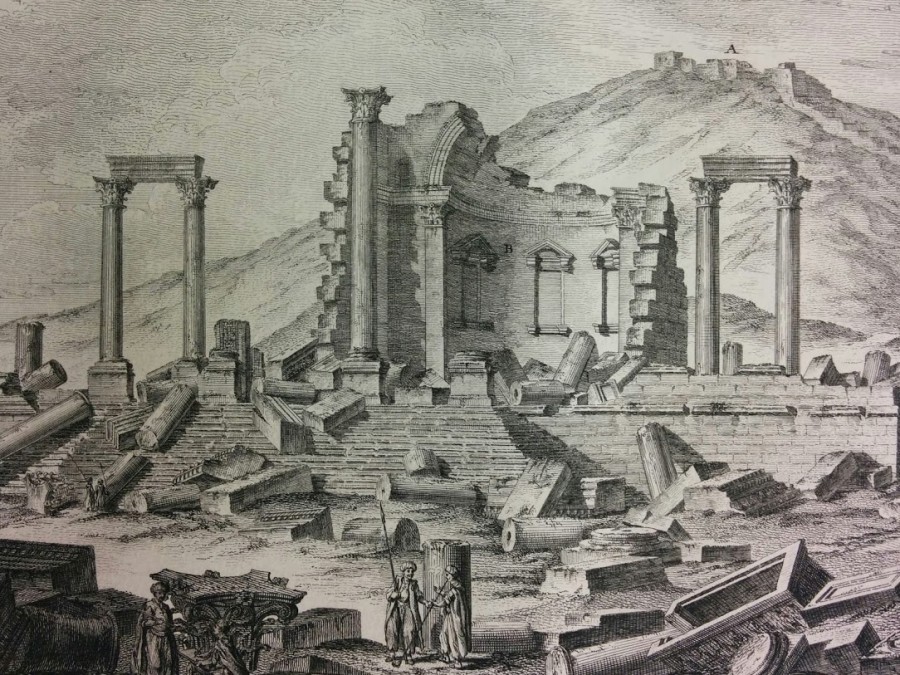
View from Robert Wood, “The Ruins of Palmyra.”
“Does not even this silence of history carry with it instruction, and teach us how much we are in the dark with regard to some periods of antiquity?” (Robert Wood)
I think there is a kind of misconception that history has already taught us all it has to teach; that because its rough outline and skeletal framework are so well known to us, we know all of it.
But think about space for a moment. You know: the final frontier. Until recently I thought I ‘got’ the solar system: there were roughly eight (really nine, though) planets, they circled the sun, and they were all pretty dead. Orbs of rock and gas. A few pebbles spinning in between them. In just the last two years, though, my entire conception has been overturned. There is water on Mars. Pluto has an atmosphere and spews out ice glaciers. We landed a probe on the snowball surface of a comet. Titan has lakes of liquid methane. Iapetus looks like the Death Star.
The solar system is infinitely richer, more densely packed with movement and activity, than I had ever dreamed. We just had to look more closely at it.
I’m pretty sure history is the same way. There’s more to learn. There’s more to uncover.
Okay. We’ve talked about the importance of understanding history, not flattening it but bringing knowledge of it into the present as a way of evaluating our world views and our decisions. But why do physical artifacts matter? Why should we care about losing the physical city of Palmyra when people are at risk?
To me the answer has to do with how we come to know any history in the first place. History is not just “the past” in the abstract. History only exists insofar as we know it.
And in some places history is told through stories. In other places it is told through artifacts and buildings. In this place, in Palmyra, as Robert Wood pointed out, we have few ancient records. The stones were left to tell their own story. Once the stones are gone, there is essentially no history left.
We just have Robert Wood’s book. His account is now in some ways our closest link to Palmyra as it was.
And it’s sitting in the library below our studios.
You can read it yourself in the rare book room. Just follow the bibliographic address, below. May it remind us never to flatten history.
Image and Quote Source (unless otherwise noted):
Wood, Robert. The Ruins of Palmyra Otherwise Tedmor, in the Desart. London: Printed in the Year, 1753. UW Musagetes Architecture Library Rare Books.
Samuel Ganton is a graduate student at the University of Waterloo School of Architecture. His thesis research focuses on designing a thunderstorm observatory on a lake in Venezuela.


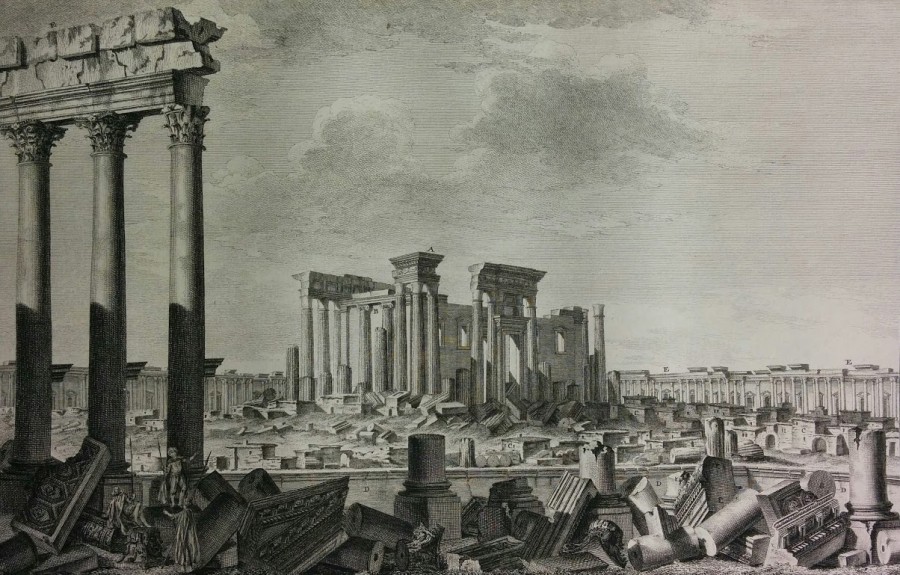
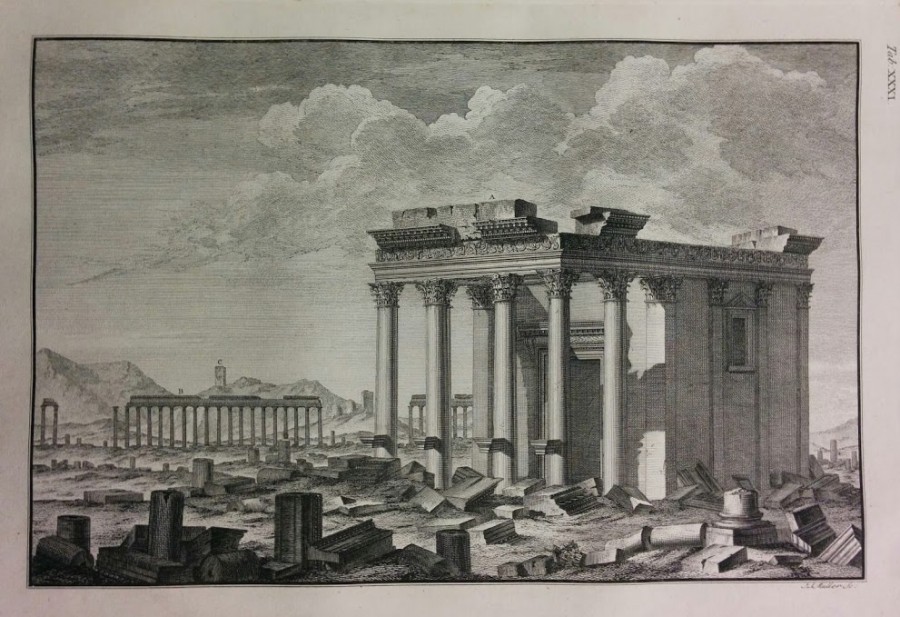


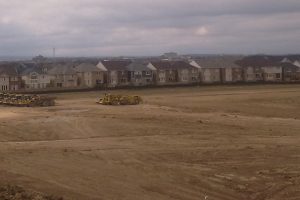
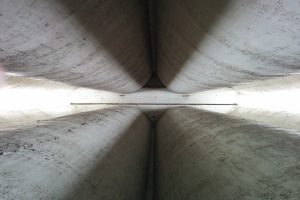

2 Comments
Leave your reply.